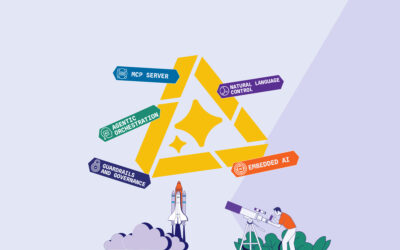Insurers that can build, test, and launch products quickly will gain significant competitive advantages, and low code/no code tools are their go-to technology in the quest for speed.
Let’s face it: insurance hasn’t traditionally been an industry known for agility. For decades, the tried-and-true approach worked. Customers had limited expectations and success was largely tied to how well the insurer managed financial risks through investments and actuarial science.
Today, It’s no longer enough to build and sell the right products. Customers hold all the cards, and their preferences can change on a dime, so speed and agility need to be on every insurance company’s agenda. That’s why insurers need the ability to launch new products fast and personalize policy features as the situation warrants.
Legacy Technology Puts Insurance Innovation in Peril
According to Deloitte, 45% of insurers say meeting evolving customer needs and expectations will be a major challenge in the next three years. But for insurance companies that are living in a legacy enterprise system world, creating a culture of speed and innovation is easier said than done.
One of the most crippling factors for insurance product development is that changes or updates often require layers of approvals even before getting added to the IT queue before months-long implementation. It’s a process that comes at a substantial cost in time, money, and lost opportunity. By the time an IT project is complete and it rolls out, the likelihood is you’re already behind the curve and customers have moved on.
Low code/no code tooling is becoming a must-have methodology for solving these woes… It’s a radically different way to turn innovative ideas into market-ready products — without requiring a massive IT undertaking.
Simplify and Accelerate Insurance Product Development
Insurers that are able to accelerate how they build, test, and launch products will gain a significant differentiation advantage for years to come. Take life insurance products, for example. They have endless attributes, such as payment schemes, renewals, duration, and regulatory requirements. Configuring an insurance product through the typical “waterfall” development process can take quarters or years — not nearly fast enough to adapt to fickle customer tastes. And, as soon as you’ve made one needed update, you’re behind the curve again. Rather than driving innovation and change in your industry, you’re always playing catch-up.
Low code/no code provides a far simpler path for insurers to build out an idea. It reduces or removes the burden of product development from IT, opening up innovation activities to those without a coding background. By creating “citizen developers,” low code/no code tools democratize the way products are created and deployed, reducing development cycles to days or weeks.
What’s it like to work in a low code/no code development environment? Instead of hard coding, you can start building a product by “toggling” product attributes on or off. By dragging and dropping elements, you can easily experiment and prototype. Standardized, reusable components enable you to get a head start on executing your idea.
By making product development as simple as dragging and dropping desired components into a workflow through visual modeling, low code/no code tools unlock tremendous advantages for insurers, including:
- Accelerating time to market
- Building solutions without straining IT resources
- Creating a culture of innovation and unleashing untapped talent in the organization
- Standardizing technical assets and methodologies
Real-World Results of Low Code/No Code Tooling
One of North America’s largest P&C insurers faced pressure to grow its written premium and outshine the competition. As part of an enterprise-wide transformation initiative, the company deployed EIS Suite as the coretech backbone for personal and commercial lines across multiple provinces.
The low code/no code DXP solution that’s part of EIS Suite is a visual modeling platform that simplifies the software development process. It replaces arcane code with a toggling, dragging-and-dropping environment that empowers product makers of every skill level — including non-technical business experts.
By allowing the insurer to put product innovation abilities into the hands of people who are closer to the customer, EIS enabled the company to strengthen its offering. Plus, they accelerated its development cycles by being able to configure a product once and leverage that configuration for all channels of distribution and digital engagement.
Low Code/No Code Tools are Not Created Equally
Using low code/no code tools can produce applications six to 20 times faster than coding from scratch. As more platform vendors enter the market with low code/no code solutions, choosing the right platform is critical. At EIS, we have created the first low code/no code platform specifically for insurance companies. Four advantages of our solution, include:
- Strong industry-specific process and compliance capability. Many low code/no code platforms are for basic or simplistic product creation. As you know, insurance is neither basic nor simplistic. EIS is built to handle all the complexity and nuance, even for multi-faceted, highly regulated products like P&C, L&A, and health insurance.
- Ability to test, learn, and address change. Modern insurance products are never really finished. They need to change and adapt to meet shifting customer needs. Built on CI/CD (continuous integration and continuous deployment) principles, EIS low code/no code tools let you build something the first time, test it and update it without opening an IT ticket.
- Ecosystem integration. Being able to tap into internal data and third-party data must be a top priority for insurance companies. With an extensive API library, the EIS DXP makes it easy to drag and drop data integrations wherever necessary.
- Multi LoB support. By enabling insurers to manage multiple lines of business from a single platform, EIS creates a true 360° real-time customer record. The more you know about your customers, the better you can personalize their products. Applying customer data throughout your low code/no code product creation efforts opens infinite possibilities for personalization and bundling.
In the midst of a pandemic and with economic headwinds at your face, there’s little doubt your organization is feeling the pressure right now to reimagine products and experiences. EIS believes low code/no code tools give insurers the speed and agility advantage needed to keep pace with changing customer behaviors and motivations.
Contact us today to learn more about how our platform can help you move beyond legacy systems and give you the agility you need to stay ahead of the curve.




